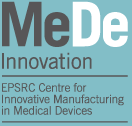National Capability Database | Capability Detail
Professor Phil Coates
p.d.coates@bradford.ac.uk
Solid Phase orientation of biomedical or inert polymers
Capability Description
The Polymer IRC at Bradford has unique worldwide experimental and modelling facilities for ‘process structuring’, in this first case for deformation processing of polymers in the solid phase. Our extensive range of processes, particularly die drawing (invented by us) allow us to obtain oriented materials in solid or hollow section form in a highly controlled manner and at commercially viable production rates, which exhibit significantly enhanced physical properties. We have extensive facilities for die drawing: large scale batch and continuous die drawing (typical products from ~5mm to 200mm thickness), small to micro scale die drawing (mainly batch, for products of 1-5mm thickness, or tubes down to ~100 micron wall thickness, continuous process in development). We have expertise in die design for solid and hollow section products, which may also have controlled surface roughness.
In addition, we have 2 controlled constant width and biaxial stretching facilities with temperature control, and a third stretcher due.
Deformation processing can be computer monitored by video, with subsequent image analysis. Finite element analysis techniques have been developed to fully model the deformation processing.
[Prof P D Coates, Dr P Caton-Rose, Prof J Sweeney, Dr A L Kelly]
Case Study
We have undertaken extensive research programmes with Smith & Nephew for oriented polymer shape memory materials aimed at cementless fixation devices for soft tissue or bone fixation. These may be bioresorbable or non-resorbable, filled or unfilled. For example, in one format, heat is used to trigger the recovery of orientation and hence shape change, in another format body temperature recovery is possible. We hold four patents (2012) with Smith & Nephew for shape memory technology. The company have undertaken cytotoxicity and various clinical tests including bioresorbability and pull out strengths in cadavers. A new (starts 2014) EPSRC project with Smith & Nephew, Purac, Wittman Battenfeld and Invibio will include manufacture of biomedical shape memory products (tissue fixations)
Die drawn oriented polymer tubes have been explored for novel arterial stents, using micro-scale die drawing. Arterius, an SME, and Bradford have a recent patent (2014) for this application. Initial clinical work undertaken by Sheffield.








